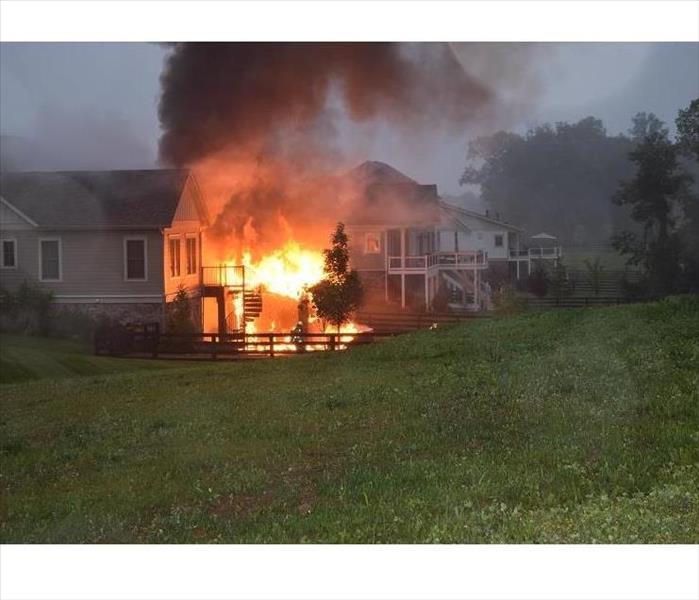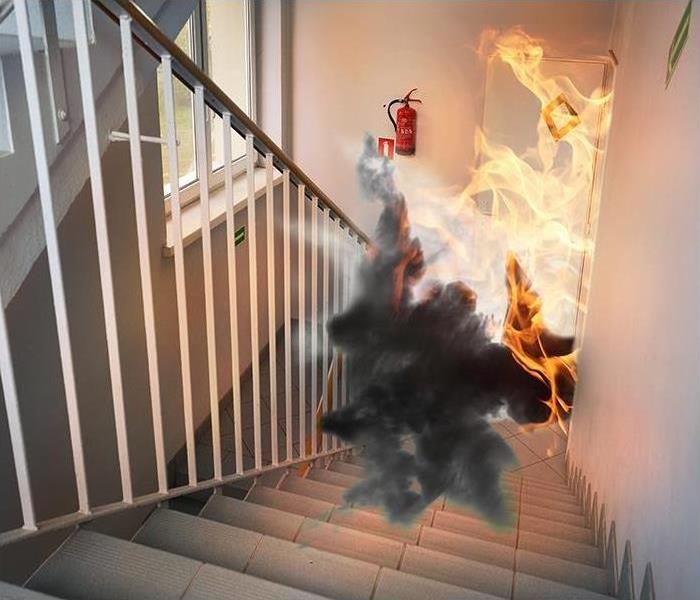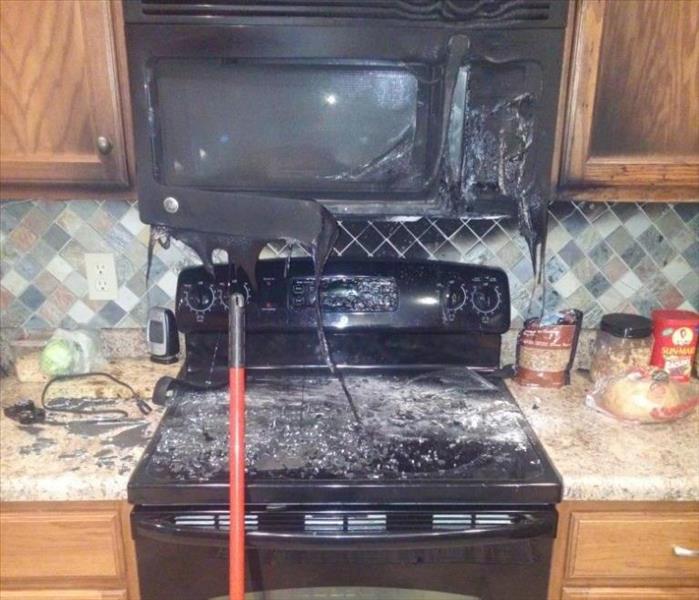Recent Fire Damage Posts
The Importance of Cleaning Upholstery After a House Fire
12/11/2024 (Permalink)
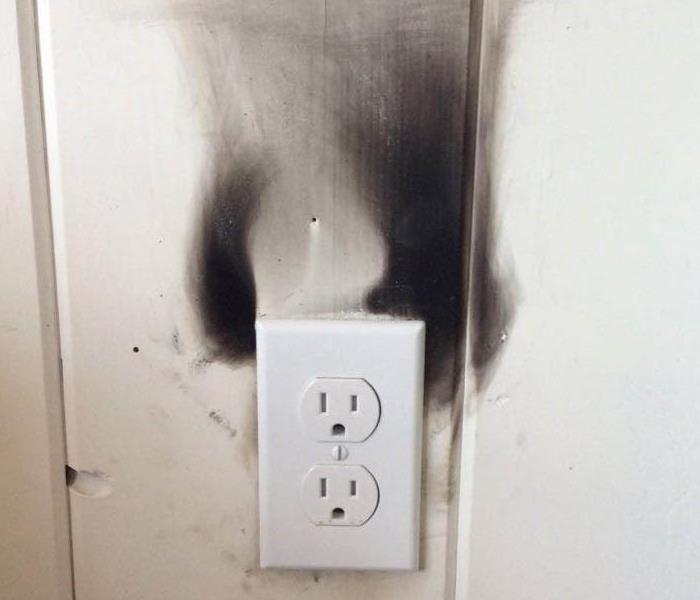 Taking care of your furniture quickly can help save it, restore your home, and keep long-term damage from getting worse.
Taking care of your furniture quickly can help save it, restore your home, and keep long-term damage from getting worse.
According to the National Fire Protection Association (NFPA), in 2020, there were over 490,000 structure fires in the United States. Each of these fires resulted in damage that affected homes and their contents, including furniture. Smoke, soot, and ash can settle deep into the fabric of your furniture, making it essential to clean your upholstery after a fire. Taking care of your furniture quickly can help save it, restore your home, and keep long-term damage from getting worse.
Reasons to Clean Upholstery After a Fire
- Prevent More Damage: Upholstery can absorb smoke, soot, and ash very easily. The longer these particles sit in the fabric, the harder it will be to get them out. If you don’t clean them properly, they can break down the fibers in your furniture, causing permanent damage.
- Remove Odors: Smoke odors cling to upholstery long after the fire is out. Regular cleaning methods won’t cut it to remove these odors because they only clean the surface. Professional cleaning uses advanced techniques to get deep into the fabric and eliminate the smell at its source.
- Restore Appearance: Soot can leave ugly stains on your furniture. With proper cleaning, these stains can be lifted, helping your furniture look like new again. This can save you money by preventing you from having to buy new furniture.
- Save Special Items: After a fire, you may worry about losing items that are valuable or sentimental. Cleaning your upholstery properly can help save those pieces of furniture that are important to you, such as family heirlooms or custom-made items.
Professional Upholstery Cleaning Techniques
Cleaning fire-damaged upholstery isn’t something you can handle with store-bought cleaning products. SERVPRO of Lewiston-Auburn uses special cleaning techniques and tools to tackle the damage left behind by a fire.
Here are some methods professionals use to clean upholstery:
- Dry Cleaning: Used for delicate fabrics, dry cleaning uses special sponges or solvents to lift soot without damaging the material.
- Wet Cleaning: For more durable fabrics, wet cleaning with water-based solutions can remove soot and other debris.
- Foam Cleaning: This method is used for delicate fabrics that need gentle cleaning. The foam removes dirt without soaking the material.
- Deodorization: After cleaning, professionals use special deodorizers to get rid of any lingering smoke smell. Techniques like ozone treatment can reach deep into the fibers to eliminate odors for good.
Steps You Can Take While Waiting for Professional Help
While it’s best to leave the heavy cleaning to professionals, there are a few things you can do to help minimize damage while waiting for help:
- Avoid Using the Furniture: Try not to sit on or use fire-damaged furniture to avoid pushing soot deeper into the fabric.
- Vacuum the Surface: If it’s safe, you can vacuum the surface of the upholstery to remove loose soot. Be gentle and avoid using too much pressure.
- Cover Upholstery: While waiting for professional cleaning, cover the upholstery with clean sheets to prevent more soot from settling.
SERVPRO of Lewiston-Auburn Is Here to Help®
Cleaning upholstery after a fire takes experience, special tools, and a thorough approach. SERVPRO® specializes in fire damage restoration and has the expertise to restore your furniture and belongings. We know every fire situation is different, and we work hard to tailor our cleaning techniques to your needs.
Understanding Fire Safety Codes and Regulations
8/14/2024 (Permalink)
As a property manager in Lewiston, ME, ensuring your property meets local fire safety codes and regulations is essential. Compliance not only protects your investment but also ensures the safety of occupants. In this blog, we'll cover the key aspects of fire safety codes in Lewiston and how we can assist you in maintaining compliance.
The Importance of Fire Safety Codes
Fire safety codes are designed to minimize the risk of fire and enhance the safety of buildings and their occupants. Understanding and complying with these regulations can prevent devastating fire incidents and ensure a quick and effective response if one occurs.
Protecting Lives and Property
The primary goal of fire safety codes is to protect lives and property. Adhering to these regulations ensures that buildings have the necessary fire prevention, detection, and suppression systems in place.
Legal Compliance
Failure to comply with local fire safety codes can result in fines, legal liabilities, and increased insurance premiums. Ensuring your property meets these standards helps avoid these consequences.
Key Fire Safety Codes and Regulations in Lewiston, ME
Lewiston has specific fire safety codes and regulations that property owners must follow. Here are some key areas to focus on:
1. Fire Alarms and Detection Systems
Local codes require the installation of smoke detectors and fire alarms in residential and commercial buildings. These systems must be regularly tested and maintained to ensure they are functioning correctly.
2. Fire Extinguishers
Fire extinguishers should be strategically placed throughout the property, especially in kitchens, hallways, and near exits. Regular inspections and maintenance are necessary to ensure they are ready for use in an emergency.
3. Emergency Exits and Evacuation Plans
Buildings must have clearly marked emergency exits and evacuation routes. Ensure that these exits are unobstructed and that evacuation plans are posted and communicated to all occupants.
4. Sprinkler Systems
In certain buildings, such as multi-family residences and commercial properties, sprinkler systems are mandatory. These systems must be inspected and tested regularly to ensure they can effectively control or extinguish a fire.
5. Electrical Safety
Outdated or faulty electrical systems are a common cause of fires. Regular inspections and upgrades are necessary to ensure electrical systems meet current safety standards.
Ready to Ensure Compliance and Safety?
Understanding and adhering to fire safety codes and regulations in Lewiston, ME, is crucial for protecting your property and its occupants. When it comes to fire safety, don't take chances.
If your home or business suffers from fire damage, don’t hesitate and give our SERVPRO of Lewiston-Auburn team a call today! Let our experienced team help you restore your property back to preloss conditions!
The Dangers of Gas Leaks and How to Detect Them
4/17/2024 (Permalink)
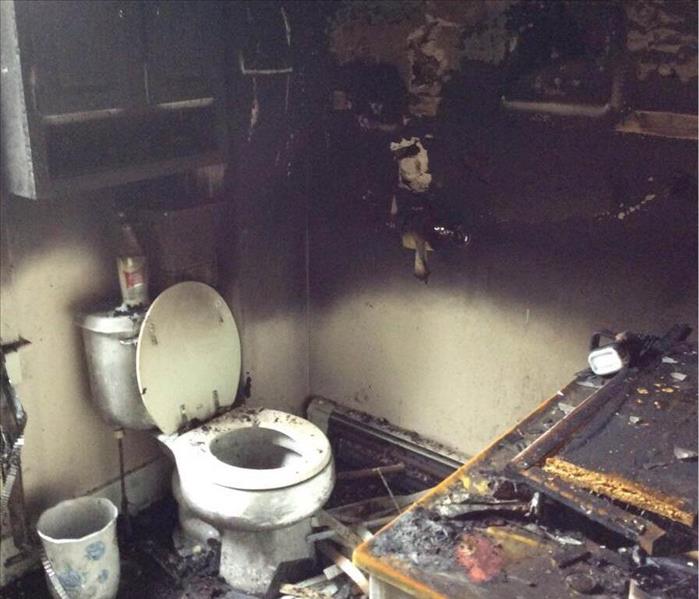 In this blog, we will explore the dangers of gas leaks and discuss effective methods for detecting them.
In this blog, we will explore the dangers of gas leaks and discuss effective methods for detecting them.
Gas leaks pose a significant risk to both residential and commercial properties. A gas leak can lead to devastating gas fires, causing extensive damage, potential injuries, and even loss of life. Detecting gas leaks early is crucial in preventing these hazardous situations. In this blog, we will explore the dangers of gas leaks and discuss effective methods for detecting them. By understanding the risks and knowing how to identify gas leaks, you can take the necessary steps to protect your property and minimize the potential for gas fires.
The Dangers of Gas Leaks
Gas Fires
A gas leak can quickly escalate into a gas fire when exposed to an ignition source. Gas fires are highly destructive and can spread rapidly, engulfing a property within minutes. The intense heat and flames from these fires can cause extensive damage to structures, possessions, and essential infrastructure, making fire damage restoration a complex and costly process.
Explosion Hazards
When gas leaks accumulate in confined spaces, the risk of explosion increases significantly. An explosion caused by a gas leak can result in catastrophic consequences, causing severe damage to the property and endangering the lives of people in the vicinity. The force of the explosion can lead to structural collapse, making the property uninhabitable and necessitating extensive fire remediation efforts.
Detecting Gas Leaks
Pay Attention to the Smell
Natural gas has a distinct odor, often described as a "rotten egg" or sulfur-like smell. Gas companies add a chemical called mercaptan to natural gas, which gives it this noticeable odor. If you smell gas in your property, it may indicate a gas leak. Promptly turn off the gas supply and contact your gas provider for immediate assistance.
Listen for Unusual Sounds
Gas leaks can sometimes produce hissing or whistling sounds. If you notice unusual sounds near gas appliances, gas lines, or meters, it may indicate a gas leak. Be attentive and don't ignore any unexpected noises related to your gas supply.
Monitor Gas Bills
Unexplained increases in gas bills can be an indication of a gas leak. If your gas consumption remains consistent but your bills are significantly higher than usual, it's worth investigating further. A gas leak could be causing gas to escape from your system, resulting in increased gas usage and costs.
Use a Gas Leak Detector
Gas leak detectors are portable devices specifically designed to detect and locate gas leaks. These handheld devices use sensors to detect the presence of gas in the air. When using a gas leak detector, follow the manufacturer's instructions and prioritize safety at all times.
Install Gas Leak Alarms
Gas leak alarms are similar to smoke alarms and can provide an additional layer of protection and early warning in case of a gas leak. These alarms are equipped with sensors that detect gas and emit a loud siren or alarm sound to alert occupants of the property. Install gas leak alarms near gas appliances, water heaters, and other potential sources of leaks.
Response to Gas Leaks
If you suspect a gas leak in your property, follow these steps:
Evacuate Safely
If you smell gas or suspect a gas leak, evacuate the property immediately. Ensure everyone leaves the premises promptly and gathers at a safe location outside, away from potential sources of ignition.
Call Emergency Services
Contact emergency services from a safe location. Inform them about the suspected gas leak and provide accurate information about the location of the property. They will be able to take appropriate action and coordinate efforts to address the gas leak promptly.
Engage Professional Fire Damage Restoration Services
After a gas leak incident, it is essential to engage the services of professional fire damage restoration experts like SERVPRO®. Fire damage restoration specialists possess the expertise, experience, and equipment to assess the property, mitigate any lingering risks, and restore it to its pre-incident condition safely and efficiently.
Detecting gas leaks early is crucial in preventing gas fires and potential explosions. By recognizing the dangers associated with gas leaks and knowing how to detect them through smell, and sound, monitoring gas bills, using gas leak detectors, and installing gas leak alarms,
Smoke and Soot Cleanup
2/28/2018 (Permalink)
Smoke and soot is very invasive and can penetrate various cavities within your home, causing hidden damage and odor. Our smoke damage expertise and experience allows us to inspect and accurately assess the extent of the damage to develop a comprehensive plan of action.
Smoke and soot facts:
- Hot smoke migrates to cooler areas and upper levels of a structure.
- Smoke flows around plumbing systems, seeping through the holes used by pipes to go from floor to floor.
- The type of smoke may greatly affect the restoration process.
Different Types of Smoke
There are two different types of smoke–wet and dry. As a result, there are different types of soot residue after a fire. Before restoration begins, SERVPRO of Lewiston-Auburn will test the soot to determine which type of smoke damage occurred. The cleaning procedures will then be based on the information identified during pretesting. Here is some additional information:
Wet Smoke – Plastic and Rubber
- Low heat, smoldering, pungent odor, sticky, smeary. Smoke webs are more difficult to clean.
Dry Smoke – Paper and Wood
- Fast burning, high temperatures, heat rises therefore smoke rises.
Protein Fire Residue – Produced by evaporation of material rather than from a fire
- Virtually invisible, discolors paints and varnishes, extreme pungent odor.
Our Fire Damage Restoration Services
Since each smoke and fire damage situation is a little different, each one requires a unique solution tailored for the specific conditions. We have the equipment, expertise, and experience to restore your fire and smoke damage. We will also treat your family with empathy and respect and your property with care.
Have Questions about Fire, Smoke, or Soot Damage?
Call Us Today – 207-783-2500
Smoke and Soot Cleanup
2/2/2018 (Permalink)
Smoke and soot is very invasive and can penetrate various cavities within your home, causing hidden damage and odor. Our smoke damage expertise and experience allows us to inspect and accurately assess the extent of the damage to develop a comprehensive plan of action.
Smoke and soot facts:
- Hot smoke migrates to cooler areas and upper levels of a structure.
- Smoke flows around plumbing systems, seeping through the holes used by pipes to go from floor to floor.
- The type of smoke may greatly affect the restoration process.
Different Types of Smoke
There are two different types of smoke–wet and dry. As a result, there are different types of soot residue after a fire. Before restoration begins, SERVPRO of Lewiston-Auburn will test the soot to determine which type of smoke damage occurred. The cleaning procedures will then be based on the information identified during pretesting. Here is some additional information:
Wet Smoke – Plastic and Rubber
- Low heat, smoldering, pungent odor, sticky, smeary. Smoke webs are more difficult to clean.
Dry Smoke – Paper and Wood
- Fast burning, high temperatures, heat rises therefore smoke rises.
Protein Fire Residue – Produced by evaporation of material rather than from a fire
- Virtually invisible, discolors paints and varnishes, extreme pungent odor.
Our Fire Damage Restoration Services
Since each smoke and fire damage situation is a little different, each one requires a unique solution tailored for the specific conditions. We have the equipment, expertise, and experience to restore your fire and smoke damage. We will also treat your family with empathy and respect and your property with care.
Have Questions about Fire, Smoke, or Soot Damage?
Call Us Today – (207) 783-2500
SERVPRO is “Ready for whatever happens.” YOU CAN BE TOO THIS SUMMER
7/5/2017 (Permalink)
Each year, families and friends across the country enjoy the summer months with barbecues, camping trips, or by cooking off in a pool or lake. To enjoy these occasions, it is important to keep safety top of mind to ensure you have fun in the sun.
According to recent study by the U.S Consumer Product Safety Commission, nearly 11,900 Americans were injured by fireworks in 2015, with the majority happening in the month surrounding the Fourth of July. Another 8,700 are injured by charcoal/wood-burning and propane grill fires. A grill should always be supervised when in use. Keep children and pets a safe distance from the grilling area to prevent accidental burns or tipping the grill.
Grills also cause an average of 8,900 home structure or outdoor fires. :These fires caused an annual average of 50 civilian injuries and $2 million in direct property damage,” according to the National Fire Protection Association (NFPA).
If you enjoy lounging by the pool or going for a boat ride to cool off from the summer sun, make sure you exercise caution, especially when children are present. Only swim in approved areas and supervise children at all times when near the water.
The summer season should be a time to make memories and enjoy the great outdoors. Don’t become a statistic. Take precautions to prevent these events from putting a damper on your summer months!
Can you escape a fire in less than 2 minutes?
2/21/2017 (Permalink)
Every second counts during a fire. Fire experts agree, people have as little as two minutes to escape a burning home before it’s too late to get out. * In a matter of moments, a small flame can become a major fire, making it critical to be prepared and have an escape plan in place. A survey conducted by the American Red Cross shows only 26 percent of families have developed and practiced a home escape plan. Once a plan is developed, it is critical everyone in the home understands the plan; the best way to do this is by practicing the escape plan at least twice a year. Increase your chance of surviving a fire by ensuring you have working smoke detectors in place, building an escape plan, and then practicing the escape plan. The following are a few suggestions to help you develop an emergency escape plan.
- Draw a map of each level of your home and show all doors and windows. Find two ways to get out of each room. Make sure all doors and windows that lead outside open easily.
- Consider escape ladders for sleeping areas on the second and third floors. Only purchase collapsible escape ladders evaluated by a recognized testing laboratory. Store them near the window where they will be used.
- Choose an outside meeting place a safe distance in front of your home where everyone can meet after they’ve escaped. Make sure to mark the location of the meeting place on your escape plan.
- Teach children how to escape on their own in case you cannot help them. Plan for everyone in your home with special considerations for elderly or disabled individuals.
- Practice your fire escape plan during the day and at nighttime.
Escape Planning for your Business
An emergency escape plan is not required for all businesses, however, Occupational Safety and Health Administration (OSHA) recommends building an emergency action plan to protect yourself, your employees, and your business during an emergency. OSHA suggest the following steps when developing such a plan.
- Organize an Emergency Preparedness Procedure review with employees to review your company’s emergency plans.
- Once a plan is developed, post evacuation procedures including routes and exits, where they are easily accessible to all employees. Ensure all exits and routes are clearly marked and well lit, wide enough to accommodate the number of evacuating personnel and unobstructed and clear of debris at all times.
- Conduct office evacuation exercises and drills. Designate a safe spot outside of all the facility where employees can regroup, recover and conduct a head count. Once completed, evaluate how well the plan worked and if additional training or exercises are needed.
Tips provided by the National Fire Protection Association and the Occupational Safety and Health Administration.
The DO's & DON'T's after a fire
2/21/2017 (Permalink)
A fire can leave behind soot, smoke damage and a host of other problems. Ceilings, walls, woodwork, carpeting, and floors will often need a thorough professional cleaning. If you home or business suffers a fire, it is important to take the appropriate steps to prevent further damage until SERVPRO of Lewiston Auburn arrives. The following tips may help reduce damage and increase chances of a successful restoration.
DO:
- Limit movement in the home to prevent soot particles from being embedded into upholstery and carpet.
- Keep hands clean. Soot on hands can further soil, upholstery, walls and woodwork.
- Place dry, colorfast towels or old linens on rugs, upholstery and carpet traffic areas.
- If electricity is off, empty freezer/refrigerator completely and prop doors open to help prevent odor.
- Wipe soot from chrome kitchen/bathroom faucets, trim and appliances, then protect these surfaces with a light coating of lubricant.
- If heat is off during winter, pour RV antifreeze in sinks, toilet bowls, holding tanks and tubs to avoid freezing pipes and fixtures.
- Change HVAC filters; leave system off until a trained professional can check the system.
- Tape double layers of cheesecloth over air registers to stop particles of soot from getting in or out of HVAC system.
DON’T:
- Don’t attempt to wash any walls or painted surfaces without first contacting a SERVPRO Franchise Professional.
- Don’t attempt to shampoo carpet or upholstered furniture without first consulting your SERVPRO Franchise Professional.
- Do not attempt to clean any electrical appliances (TV sets, radios, etc.) that may have been close to fire, heat or water without first consulting an authorized repair service.
- DO not consume any food or beverages that may have been stored close to fire, heat or water, as they may be contaminated.
- If ceiling is wet, do not turn on ceiling fans. Wiring may be wet or damaged and cause electrical shock, and air movement may create secondary damage.
- Don’t send garments to the dry cleaner. Improper cleaning may set in smoke odor.
Any concerns PLEASE contact SERVPRO at 207-783-2500.
Lewiston Auburn Smoke and Soot Cleanup
1/25/2017 (Permalink)
Smoke and soot is very invasive and can penetrate various cavities within your home, causing hidden damage and odor. Our smoke damage expertise and experience allows us to inspect and accurately assess the extent of the damage to develop a comprehensive plan of action.
Smoke and soot facts:
- Hot smoke migrates to cooler areas and upper levels of a structure.
- Smoke flows around plumbing systems, seeping through the holes used by pipes to go from floor to floor.
- The type of smoke may greatly affect the restoration process.
Different Types of Smoke
There are two different types of smoke–wet and dry. As a result, there are different types of soot residue after a fire. Before restoration begins, SERVPRO of Lewiston Auburn will test the soot to determine which type of smoke damage occurred. The cleaning procedures will then be based on the information identified during pretesting. Here is some additional information:
Wet Smoke – Plastic and Rubber
- Low heat, smoldering, pungent odor, sticky, smeary. Smoke webs are more difficult to clean.
Dry Smoke – Paper and Wood
- Fast burning, high temperatures, heat rises therefore smoke rises.
Protein Fire Residue – Produced by evaporation of material rather than from a fire
- Virtually invisible, discolors paints and varnishes, extreme pungent odor.
Our Fire Damage Restoration Services
Since each smoke and fire damage situation is a little different, each one requires a unique solution tailored for the specific conditions. We have the equipment, expertise, and experience to restore your fire and smoke damage. We will also treat your family with empathy and respect and your property with care.
Have Questions about Fire, Smoke, or Soot Damage? Call Us Today – 207-783-2500
 Taking care of your furniture quickly can help save it, restore your home, and keep long-term damage from getting worse.
Taking care of your furniture quickly can help save it, restore your home, and keep long-term damage from getting worse.

 24/7 Emergency Service
24/7 Emergency Service

